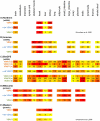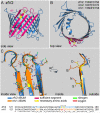VDAC2-specific cellular functions and the underlying structure
- PMID: 27116927
- PMCID: PMC5092071
- DOI: 10.1016/j.bbamcr.2016.04.020
VDAC2-specific cellular functions and the underlying structure
Abstract
Voltage Dependent Anion-selective Channel 2 (VDAC2) contributes to oxidative metabolism by sharing a role in solute transport across the outer mitochondrial membrane (OMM) with other isoforms of the VDAC family, VDAC1 and VDAC3. Recent studies revealed that VDAC2 also has a distinctive role in mediating sarcoplasmic reticulum to mitochondria local Ca(2+) transport at least in cardiomyocytes, which is unlikely to be explained simply by the expression level of VDAC2. Furthermore, a strictly isoform-dependent VDAC2 function was revealed in the mitochondrial import and OMM-permeabilizing function of pro-apoptotic Bcl-2 family proteins, primarily Bak in many cell types. In addition, emerging evidence indicates a variety of other isoform-specific engagements for VDAC2. Since VDAC isoforms display 75% sequence similarity, the distinctive structure underlying VDAC2-specific functions is an intriguing problem. In this paper we summarize studies of VDAC2 structure and functions, which suggest a fundamental and exclusive role for VDAC2 in health and disease. This article is part of a Special Issue entitled: Mitochondrial Channels edited by Pierre Sonveaux, Pierre Maechler and Jean-Claude Martinou.
Keywords: Apoptosis; Bak; Bax; Bid; Calcium; Mitochondria; Sarcoplasmic reticulum; VDAC2.
Copyright © 2016 Elsevier B.V. All rights reserved.
Figures




References
-
- Dolder M, Zeth K, Tittmann P, Gross H, Welte W, Wallimann T. Crystallization of the human, mitochondrial voltage-dependent anion-selective channel in the presence of phospholipids. J. Struct. Biol. 1999;127:64–71. - PubMed
-
- Mannella CA, Kinnally KW. Reflections on VDAC as a voltage-gated channel and a mitochondrial regulator. J. Bioenerg. Biomembr. 2008;40:149–155. - PubMed
-
- Colombini M. Pore size and properties of channels from mitochondria isolated from Neurospora crassa. J. Membr. Biol. 1980;53:79–84.
Publication types
MeSH terms
Substances
Grants and funding
LinkOut - more resources
Full Text Sources
Other Literature Sources
Molecular Biology Databases
Research Materials
Miscellaneous

